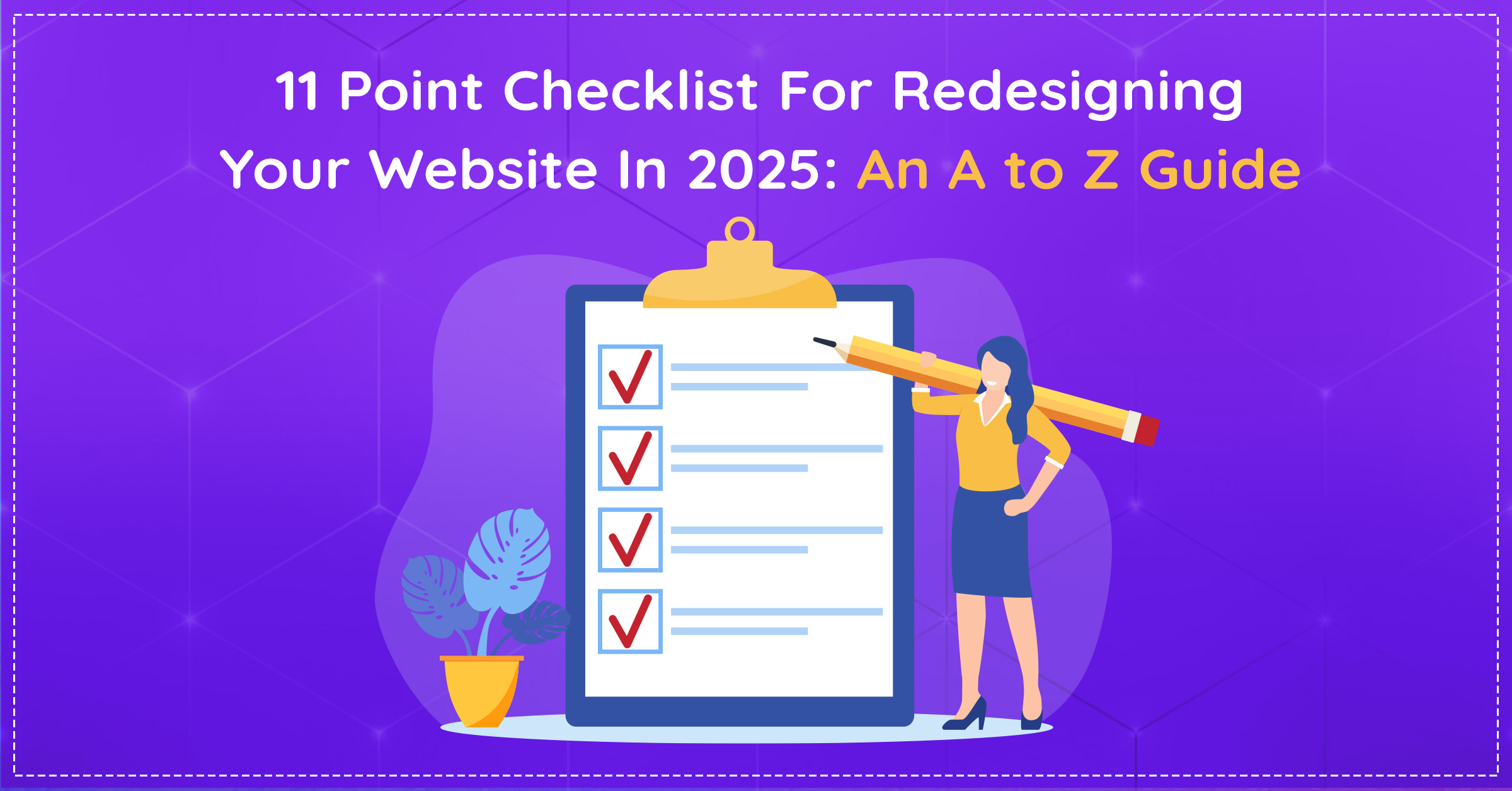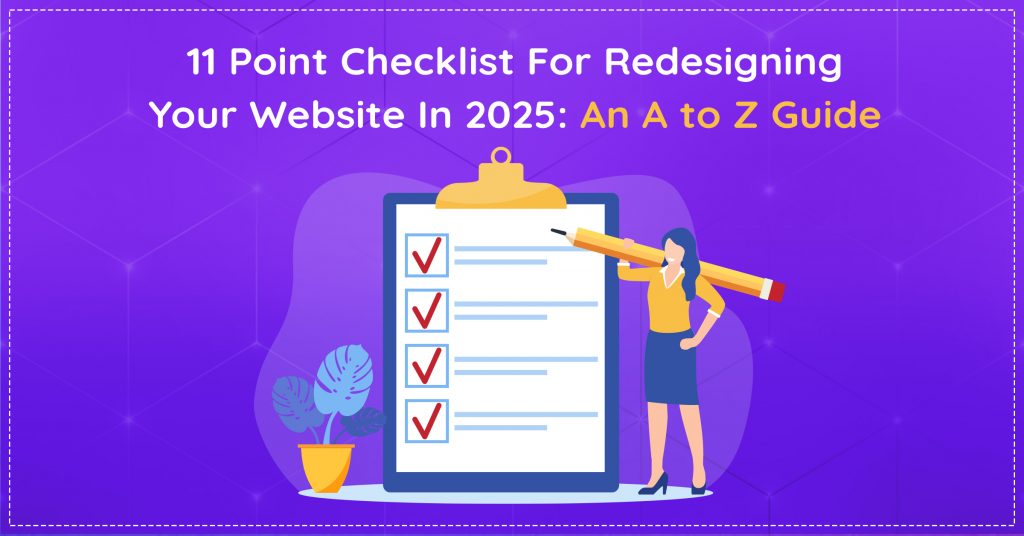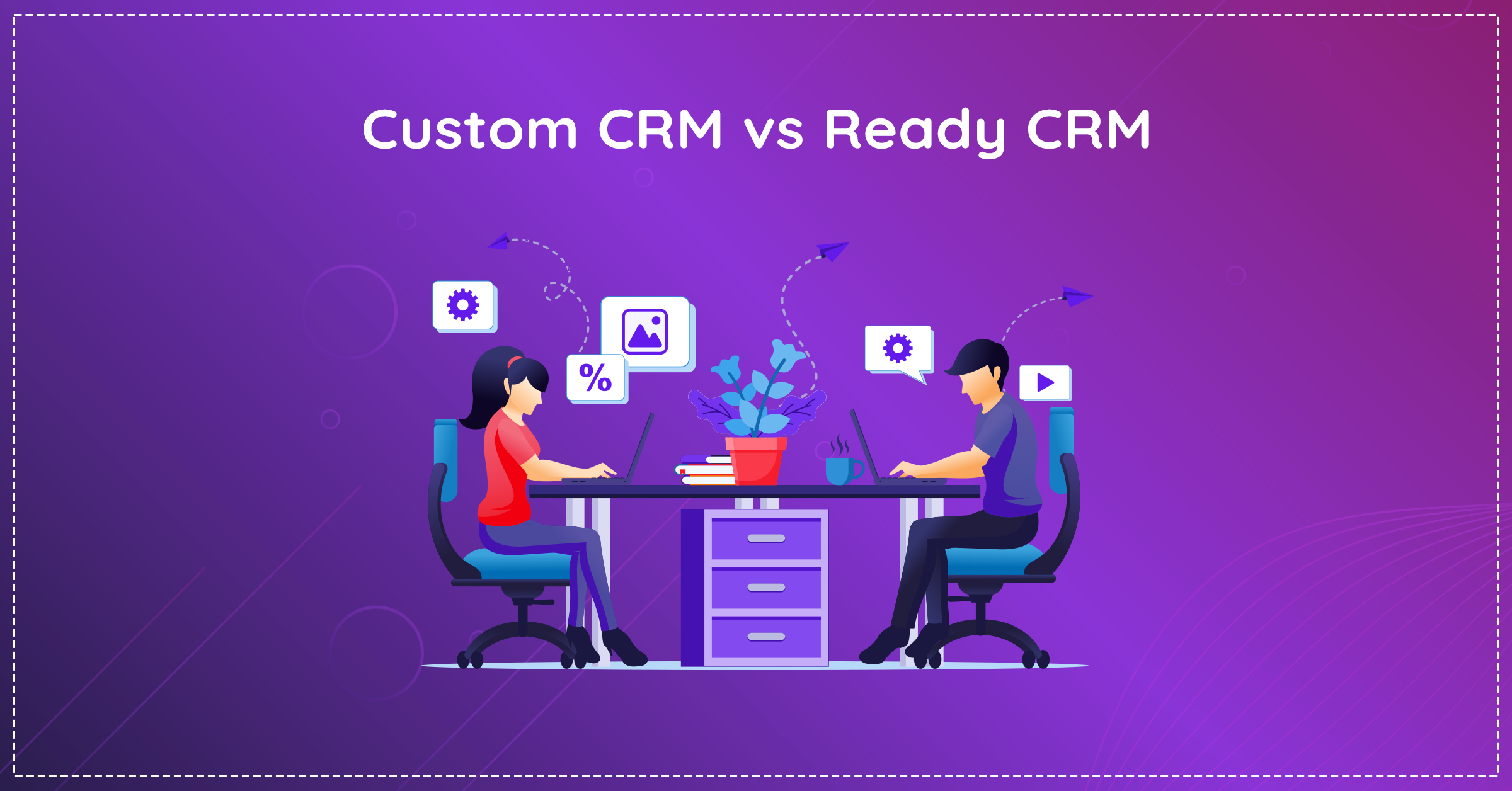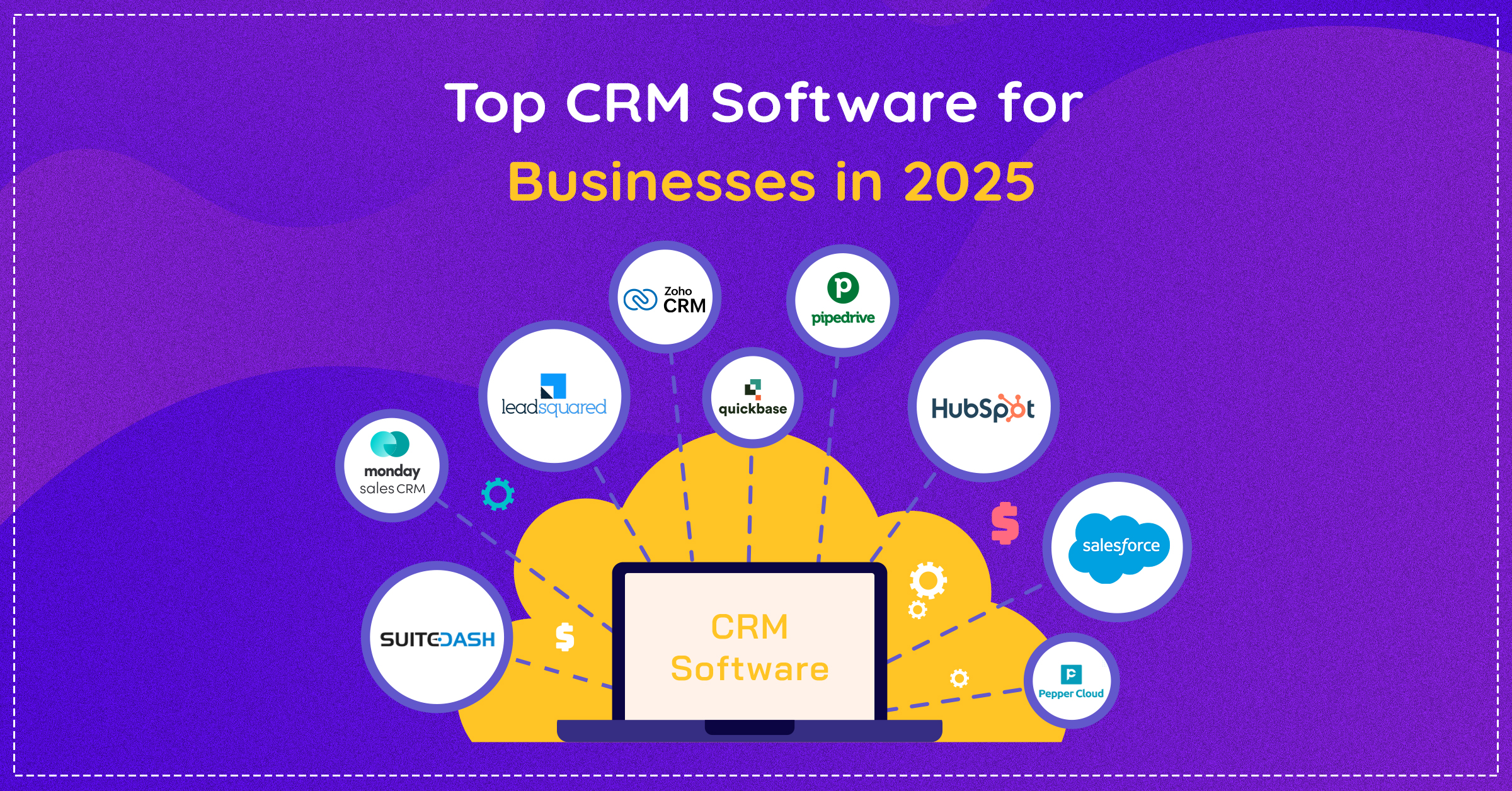In this blog, we explore the top 11-point checklist for redesigning your website in 2025, covering key factors to enhance performance and stay competitive.
With the attention span of people constantly dropping, the race in the digital realm is to grab those eyeballs and retain people on your site. In fact, numerous researchers have pointed out that websites that load faster, exhibit a visual appeal, and are mobile-friendly are more likely to retain their audiences than those without these functionalities.
That said, a poorly designed website can do more harm than good. An outdated or poorly designed site can deter visitors and hurt your credibility in the industry.
That’s why website redesigning becomes inevitable. But, what is it?
Let’s understand it in the simplest way possible.
Think of web redesigning like cleaning and organising your house during the festive season. Are we oversimplifying it? No, because the resemblance is uncanny. The trash needs to be discarded, the old needs to be cleaned and organised and the new additions need to be accommodated.
Similarly, in case of a website, the old content needs to be updated to stay relevant, the SEO elements need to be reworked, the server or host needs to be updated or changed to ensure vitality, and the website needs to be optimised to become adaptive to multiple devices.
But, how is website redesigning different from website refresh?
Well, website refresh is like a makeover. It fixates on the UX aspects of your website to enhance the experience of your audience. Website redesigning, on the other hand, is the complete overhaul, a 360 degree transformation focusing on the content, UI/UX, the technical infrastructure and other functionalities to make your site relevant and remarkable.
With that said, let’s delve deeper into our blog to get a foolproof checklist for website redesigning.
But before that, let’s have a bird eye view of what the website redesigning process looks like:
- Planning and Setting Goals: At this stage, you will analyse what you have available at hand and set realistic and achievable goals. For instance, you can analyse your website’s metrics such as audience retention rate and bounce rates and accordingly work on the UI/UX framework of your site. Moreover, you can look for inspiration from your competitors’ websites and accordingly plan your redesigning endeavours. Also, do not imitate what they’re doing because they already exist. Ask yourself: what makes us different from them?
- Design and Development: We cannot emphasise enough how important it is to choose the right web redesigning services. Although it’s a subjective decision, we would encourage you to hire or contract people who have knowledge, experience, and expertise in the domain. Most importantly, people who are easy to communicate with, don’t hesitate to simplify things for you and are transparent with what they do and how they do it. Moreover, it is also the stage wherein you need to decide what kind of website builder you want to use and the sitemap you desire for your web, as well as ensure all these moving parts are in alignment to achieve your ultimate web redesigning goal.
- Technical Aspects: Here the technical nitty-gritty of web redesigning comes into picture such as preparing a map for all URL changes to be done, optimizing images, minifying code, putting SSL certification and other security measures in place, fulfilling the legal requirements such as the GDPR, etc.
- Redesigning: This is the stage where the real action begins. Once all the desired changes are in place, you need to check all the features and functionalities in different devices, gather feedback from users and have a sound backup in case of issues with the newer one.
- Post Redesigning: Once the redesigning is done, do not sit back and relax. In fact, this is the most important stage where you can analyse and evaluate the results of your efforts. Look beyond the crude figures and understand the picture the numbers are trying to portray.
11 Checkpoints for Website Redesigning in 2025
1. Audit Your Current Website To Know What’s Wrong
When you go to a doctor, does s/he write a prescription without checking your vitals? (If yes, run away.)
The point is you cannot redesign your website without first understanding its strengths and weaknesses. Now, the question is how do you do that? The answer is very simple: metrics.
The metrics of your website can point to what’s working for you and what’s not. This information can come in handy while web redesigning.
Here are some key metrics that you can rely upon while auditing your website:
- Traffic sources: It’s important to understand where the people are coming from to your website. Is it instagram? Or Twitter? Or Facebook? Understanding the traffic sources can immensely help your content marketing strategy as a whole.
- Retention Rate: Just getting people to your site is not enough. You need to hold their attention and that’s why strong UI/UX, relatable content, and proper CTAs are so important.
- Bounce Rate: If your bounce rate is high, it points to the fact that your site is unable to hold the people who visit your site. Ask yourself; is there some issue with the loading speed? Or is the UI/UX design of your page confusing? Is the colour scheme off? Or does the web content lack clear CTAs? Answering these questions can give you a direction for channelling your resources into specific areas of web design.
- SEO Performance: Identify pages with poor rankings and investigate why they aren’t performing well. Check your site’s ranking, organic traffic, and keywords using tools like Ahrefs or SEMrush.
- Mobile Optimisation: Google is more likely to crawl, index and put your website on the first page of search results when it is optimised for mobile devices. That makes mobile optimisation a crucial component of SEO.
- Page Load Speed: This is another area of SEO that must be prioritised. On average, a page load speed for any website must not be more than 5 seconds. Yes, you read that right. If it’s more than that, your chances of getting a high bounce rate increase.
To generate all these metrics, you can use tools like Google Analytics.
Analytics can help you identify high-performing pages, user behaviour, and areas on your site needing improvement.
Moreover, do not underestimate the potential of user feedback as they speak a ton about the hits and misses of your site. You can generate audience feedback through surveys, feedback forms, or interviews. Ask users what they find confusing, frustrating, or missing from your site and use this information as a guiding post while redesigning our website.
2. Decide Your Web Redesigning Goals
Get your pen and paper out and note down what you are trying to achieve through website redesigning.
Do not have vague goals like “I want to increase sales.”
Instead, have specific, realistic and achievable goals such as “I want to increase my sales by X number by the end of Y (a deadline).”
Similarly, your goal could be driving conversions such as boosting the signups to your newsletter, improving navigation and UX, enhancing site speed, optimizing for mobile users, integrating updated branding elements, etc.
Remember, your clearly defined goals can act as the guiding posts for redesigning your website.
3. Do Competitor Research
It’s good to have an idea about what your competitors are doing right in terms of website design that allows them to stay at the top. Is it their web content? Or do they have a flawless design? What kind of content is working for them? Where are they getting most of their leads from?
Answers to these questions can help during redesigning your website. The intent is not to imitate but to take inspiration and do something unique.
4. Define Your Visual Language and Branding Tone
It’s important to get the aesthetics right.
A florist’s website with eye-popping colors and a real estate contractor’s website with flowery aesthetics cannot go together. That’s why it’s important to get your visual language right. You need to ensure that your website’s templates, UI/UX designs, fonts, colour scheme, and placement of CTAs are aligned with your business.
Moreover, focus on your business’s message. What values do you want to propagate to your audience and how do you want to share them? Instead of merely talking about your values, show how you’re creating an impact in society.
5. Create a Sitemap
Well, sitemaps are very much like them. It’s a web of all the pages you’re planning to have on your website, the content they might have in it, and how each of them will be connected.
Moreover, while making the sitemap, get the basics right such as a Home Page, an About Page, and a page dedicated to Contact Information.
Also, make sure that your sitemap makes it easier for a user to switch from one page to another within seconds.
6. Focus on Technical SEO
Technical SEO is the base upon which your website’s presence and success is dependent. Here, we’ll recommend you to focus on three crucial aspects namely; mobile optimisation, page load speed, and on page SEO.
With mobile devices accounting for over half of web traffic, responsive design is non-negotiable. While redesigning, ensure that your content and images adapt seamlessly to different devices, make buttons and menus easy to use on smaller screens, and optimise your site to load quickly on slower mobile connections.
There’s no doubt that fast-loading sites improve user experience and search rankings. To enhance your site speed while redesigning, you can distribute site content across multiple servers through a CDN, remove unnecessary code to streamline your site, and invest in a hosting service with good uptime and fast servers.
A redesign can hurt your SEO efforts if not handled carefully. Thus to avoid this, maintain current URLs or set up proper 301 redirects, optimize meta tags, headers, and Alt texts with relevant keywords and use a good SEO plugin to resolve optimization issues during development.
7. Create a Content Strategy
One of the key components of website redesigning is updating the old content on your site to ensure it remains relevant for the present audience. However, updating all the content of your website is not an easy task and sometimes even impossible. That’s why, we highly encourage you to study the most popular content on your site, understand what works for your audience and accordingly update content that has the potential to reach newer heights.
While developing a content strategy, be consistent with your intent, tone and microcopy.
What are they? Here’s a brief overview:
- Intent: What is it that you want to communicate? Instead of focusing on what you have to offer, focus on how the product or service can make a change in your audience’s life.
- Tone: How do you want to communicate it? Do you want to adopt a friendly and conversational tone or a strictly professional voice?
- Microcopy: Do the CTAs on your website align with your intent and tone? When it comes to microcopies, blend creativity with clarity while keeping the latter as your focal point.
8. Redesign Your Website
At this stage, the real work begins. Remember, redesigning your website is more than just a visual overhaul; it’s about improving functionality, user experience, and alignment with business goals.
Here, you can add or improve features like search bars, chatbots, or interactive forms to enhance user engagement. Moreover, you can work with web designers, developers, and content creators to ensure a cohesive approach to your redesign.
For more on the importance of website maintenance, check out Benefits of Outsourcing Website Maintenance.
9. Perform User Testing
You cannot afford to sit back and relax after the redesigning if you want to achieve your goals. Thus, once the redesigning has been done, it’s important to do performance user testing to validate your design decisions and ensure the new website meets user needs.
The question is: how can you do performance user testing?
Here’s what we suggest:
Get participants to perform specific tasks on the website, such as finding a product, filling out a form, or accessing a blog post. Observe their behaviour and gather feedback.
Next, identify patterns in user behaviour and pinpoint areas of confusion or frustration. Use this data to refine your design and functionality.
Lastly, make necessary changes to address user concerns, then repeat testing to validate improvements.
10. Monitor Performance
Remember those key metrics that we discussed earlier (page load speed, retention rate, bounce rate, etc)? Ringing any bells? Well, this is the time to reevaluate all these metrics and see whether an improvement has been noticed in those aspects or not.
Why is it important?
Well, tracking your website’s performance post-launch can help in measuring success and identifying areas for improvement.
11. A/B Testing
Red or Yellow? Apples or Bananas? Which one would you pick?
Why are we asking this?
Well, it’s simple, your audiences’ preferences differ and A/B testing, that is, comparing two versions of a webpage to determine which performs better can offer valuable insights into your visitors’ likes and dislikes. Although you cannot create a customised solution for every other user, you can do your best to enhance the overall user experience with this data.
For more on why website redesigning matters, check out Top Reasons to Redesign Your Website.
Conclusion
Redesigning your website is a huge investment that can transform the way users perceive and interact with your brand. By following this comprehensive checklist, you’ll ensure that every aspect of your website—design, functionality, and user experience—is optimized for success. Moreover, if you’re looking for a seasoned agency to help you with web redesigning, get in touch with our team at Eiosys where knowledge and experience blend to create magic for our clients!
For more information on professional website development services, visit our Website Development Company page here.






